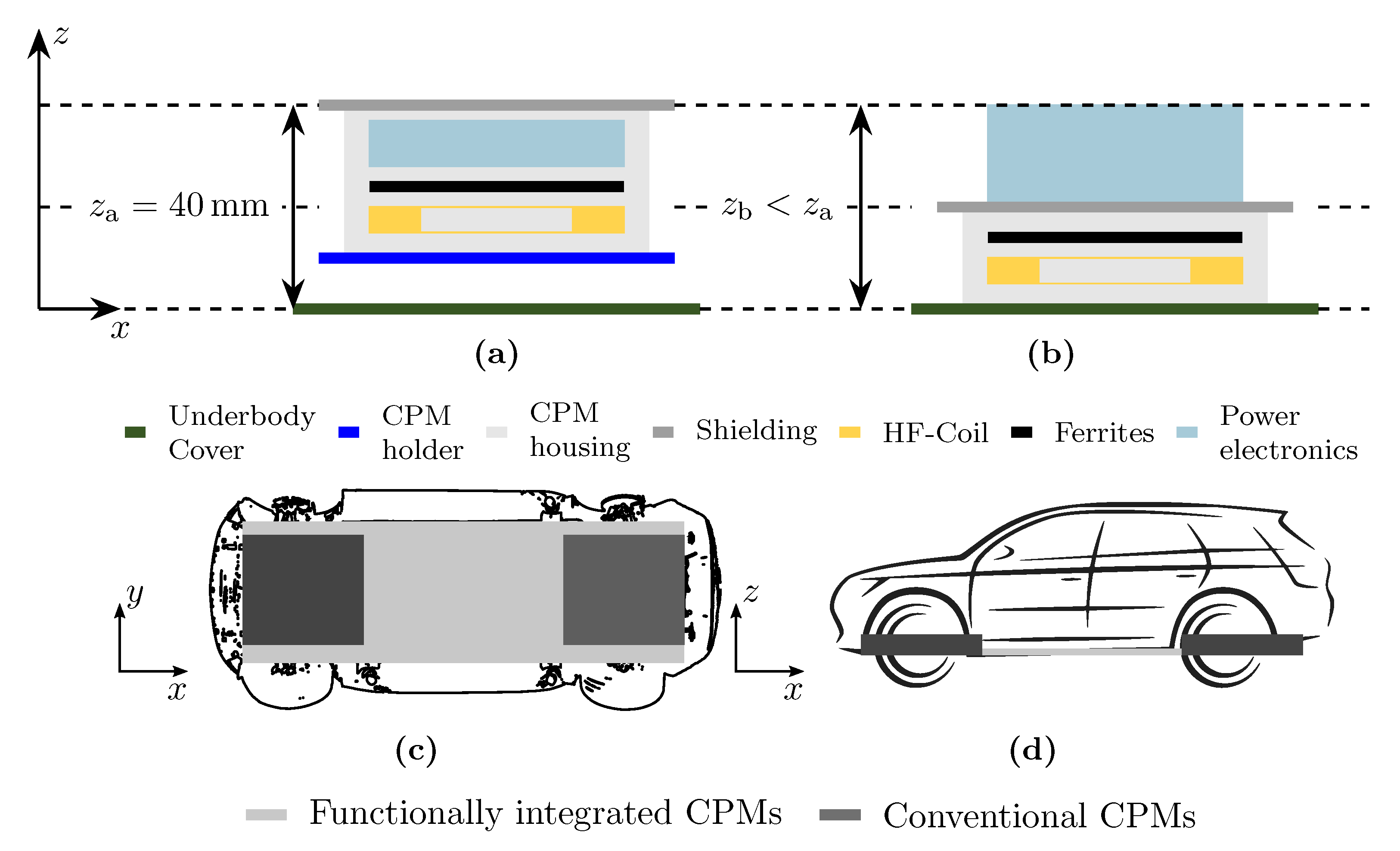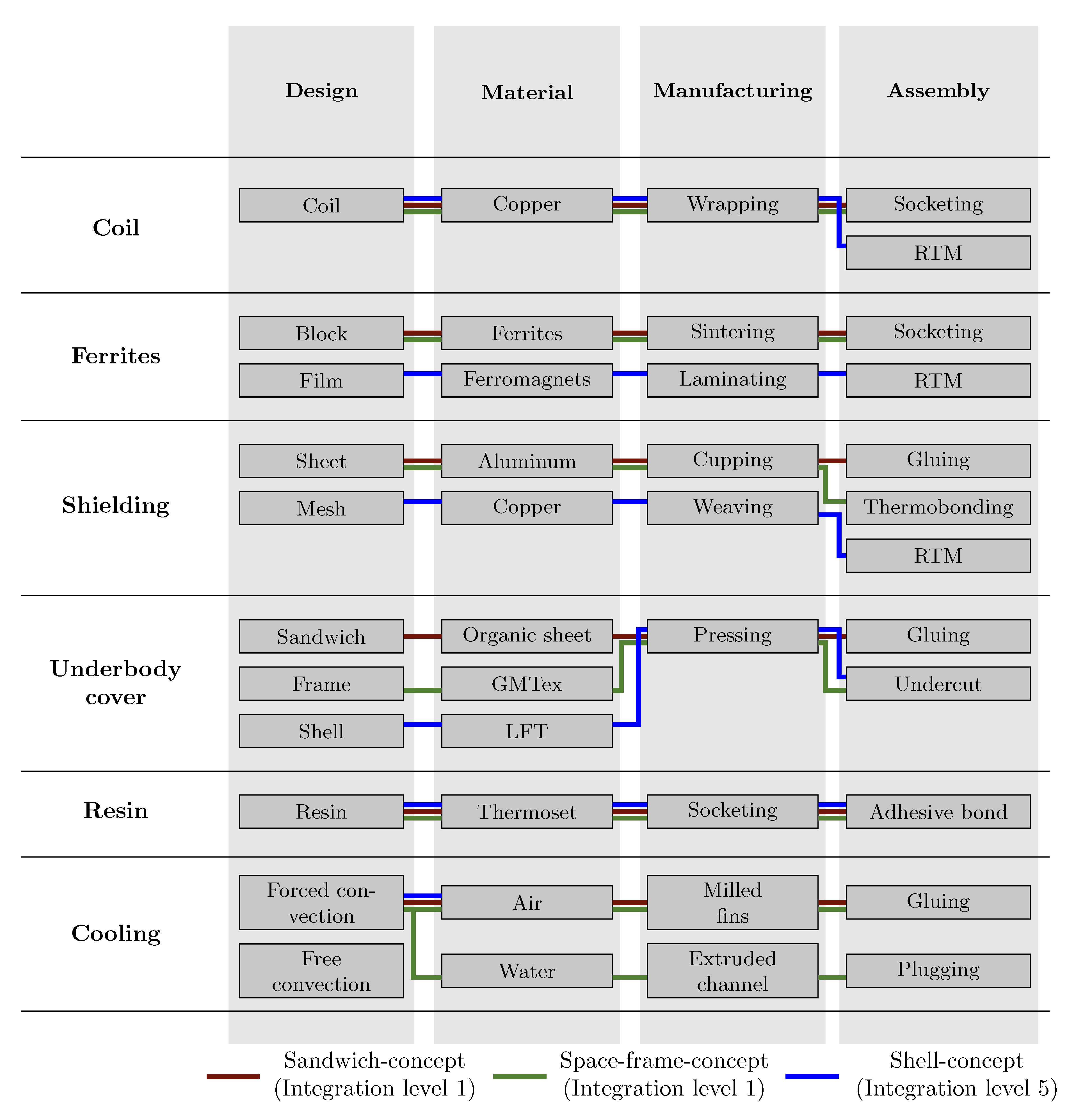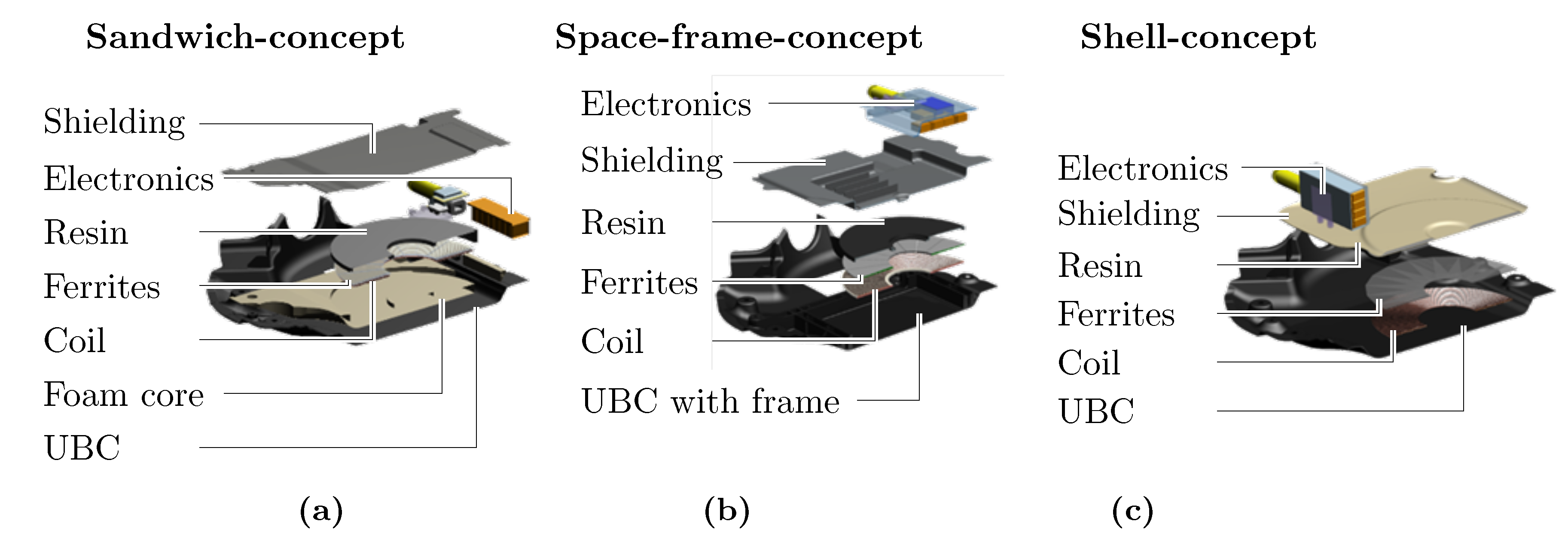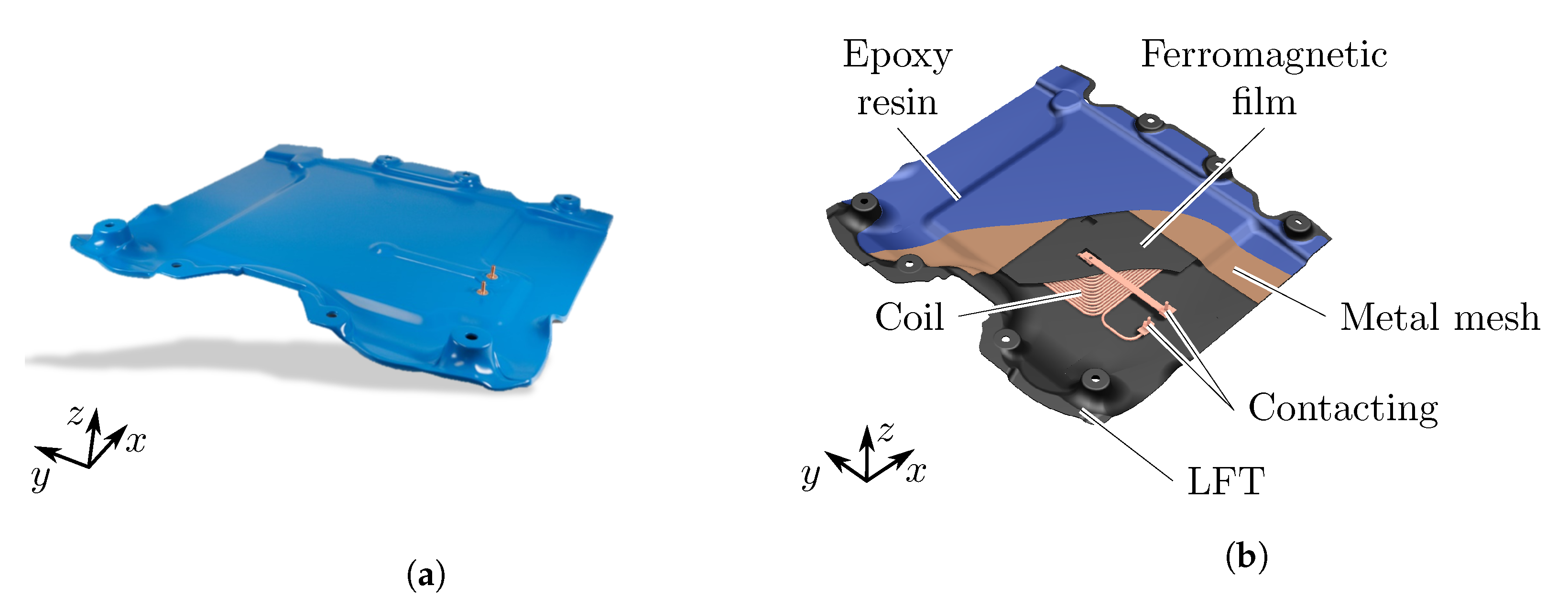Systematic Design Approach for Functional Integration of Vehicular Wireless Power Transfers Modules
Abstract
:1. Introduction
2. Functional Integration of Mechanical-Electrical Lightweight Systems
2.1. Challenges and Requirements
- Generality: The approach is independent of the specific application, i.e., solution- and product-independent. Thus, the development process is problem-specific, purpose-oriented, situation-oriented, adaptable and expandable. Consequently, it supports all types of construction (new construction, modification design and variant design).
- Totality: The approach structures the development process holistically from requirement analysis to elaboration.
- Intelligibility: The approach provides an easy-to-understand idea and consistent methodical support. Regardless of the developer’s experience, the procedure is easy to apply.
- Cross-domain collaboration: The support of a cross-domain and interdisciplinary way of working is imperative. It is supported by methods throughout the development process. In particular, the easy transition of cross-domain and domain-specific methods is taken into account.
- Interaction of product and production: The development of FIMEL requires consistent consideration of the interactions between product and production system. This interdependence is synchronized by appropriate methods.
- Equality of domains: The project-specific domains and their established way of working is treated on an equal footing and, if necessary, synchronized.
- Support of functional integration: The development of FIMEL requires the interactive coordination of design, production, dimensioning and electrical functions (see Figure 1). This results in consistent interactions of mechanical, electrical, material and process engineering as wells as assembly. The approach consistently provides methodical support for mastering these interdependencies.
- Consistent requirements management: The consistent detailing during the development process requires an end-to-end management of requirements. Consequently, the approach enables transparent analysis and synthesis of requirements and priorities along the entire development process.
- Modeling and simulation: The approach supports the implementation of mathematical, numerical and physical models, as well as simulations along the entire development process.
- Control of progress: The interdisciplinary development process of FIMEL requires the synchronization of the development results. Consequently, the approach provides stage gates or control points for synchronization as well as possibilities for progression and iteration.
2.2. State-of-the-Art Design Approaches
2.3. Needs for Action
- There is an insufficient linkage between the working strategies of the domains.
- The methodical support for an efficient and purpose-oriented development of functionally integrated products is insufficient.
- There is no guideline for the simultaneous development of novel FIMEL and its corresponding manufacturing and joining technologies.
3. V-Model to the Development of Mechanical-Electrical Lightweight Systems
4. Functionally Integrated Lightweight Designs of Vehicular Wireless Power Transfer Modules
4.1. Requirements Analysis
4.2. Conception
4.3. Integrated Design
4.4. Integrated Elaboration
5. Conclusions
Author Contributions
Funding
Institutional Review Board Statement
Informed Consent Statement
Data Availability Statement
Conflicts of Interest
Abbreviations
| CPM | Car pad module |
| ComChar | Component characterization |
| ComConc | Component conception |
| ComInt | Component integration |
| DC | Direct current |
| EVs | Electric vehicles |
| FIMEL | Functionally integrated mechanical-electrical lightweight systems |
| GMTex | Glass mat reinforced thermoplastic |
| HiL | Hardware-in-the-Loop |
| LFT | Long fiber reinforced thermoplastic |
| MACP | Macro-control-point |
| MEL | Mechanical-electrical systems |
| MICP | Micro-control-point |
| MID | Molded interconnect devices |
| ModConc | Module conception |
| ModInt | Module integration |
| MaPhMod | Mathematical-physical models |
| PCB | Printed circuit board |
| PhyMod | Physical models |
| PPS | Product-property-space |
| PSS | Product-solution-space |
| RTM | Resin transfer molding |
| SysConc | System conception |
| SysDes | System design |
| SysInt | System integration |
| UBC | Underbody cover |
| VARI | Vacuum-assisted resin infusion |
| WPTS | Wireless power transfer systems |
References
- e-mobil BW GmbH (Ed.) Strukturstudie BWe Mobil: Transformation Durch Elektromobilität und Perspektiven; e-mobil BW GmbH: Stuttgart, Germany, 2019; Available online: https://www.e-mobilbw.de/fileadmin/media/e-mobilbw/Publikationen/Studien/Strukturstudie2019.pdf (accessed on 4 May 2021).
- Leichtbau BW GmbH (Ed.) Mit Konzeptleichtbau Ungenutzte Potenziale Heben: Ökonomischer und Ökologischer Nutzen; Leichtbau BW GmbH: Stuttgart, Germany, 2018; Available online: https://www.leichtbau-bw.de/fileadmin/user_upload/PDF/Studien/LeichtbauBW_Studie_Konzeptleichtbau_2019.pdf (accessed on 4 May 2021).
- VDI Verein Deutscher Ingenieure (Ed.) Entwicklung Technischer Produkte und Systeme Modell der Produktentwicklung; VDI-Verl.: Düsseldorf, Germany, 2018. [Google Scholar]
- Vielhaber, M.; Stoffels, P. Product Development vs. Production Development. Procedia CIRP 2014, 21, 252–257. [Google Scholar] [CrossRef] [Green Version]
- Roos, M.; Wagner, C.; Weber Martins, T.; Albrecht, K.; Anderl, R.; Kirchner, E. Manufacturing-integrated product solutions: Design support between product function and manufacturing processes. Mater. Werkst. 2017, 48, 12–26. [Google Scholar] [CrossRef]
- VDI Verein Deutscher Ingenieure (Ed.) Entwicklungsmethodik für Mechatronische Systeme; VDI-Verl.: Düsseldorf, Germany, 2004. [Google Scholar]
- Nattermann, R.; Anderl, R. The W-Model—Using Systems Engineering for Adaptronics. Procedia Comput. Sci. 2013, 16, 937–946. [Google Scholar] [CrossRef] [Green Version]
- Gausemeier, J. Produkte und Produktionssysteme Integrativ Konzipieren: Modellbildung und Analyse in der Frühen Phase der Produktentstehung; Hanser: München, Germany, 2012. [Google Scholar]
- Modler, N.; Winkler, A.; Filippatos, A.; Weck, D.; Dannemann, M. Function–integrative Lightweight Engineering—Design Methods and Applications. Chem. Ing. Tech. 2020, 92, 949–959. [Google Scholar] [CrossRef]
- Helms, O. Konstruktion und Technologische Umsetzung von Hochbeanspruchten Lasteinleitungssystemen für Neuartige Leichtbaustrukturen in Faserverbundbauweise. Ph.D. Thesis, Technische Universitat Dresden, Dresden, Germany, 2006. [Google Scholar]
- Stoffels, P. Integrierte Definition von Produkt, Produktion und Material zur Steigerung der Ressourceneffizienz. Ph.D. Thesis, Universität des Saarlandes, Saarbrücken, Germany, 2017. [Google Scholar]
- Zimmer, S.; Rothenberg, S.; Tattko, B.; Baumer, T.; Baier, K.; Glöggler, C.; Winkler, A.; Modler, N. Vehicle Integration of wireless power transfer systems: An experimental safety investigation of underfloor impact scenarios. In Proceedings of the 31th International Electric Vehicle Symposium & Exhibition (EVS31), Kobe, Japan, 1–3 October 2018. [Google Scholar]
- Ziebart, J.R. Ein Konstruktionsmethodischer Ansatz zur Funktionsintegration; Produktentwicklung, Verlag Dr. Hut: München, Germany, 2012. [Google Scholar]
- Wagner, C. Funktionsintegration im Rahmen Einer Fertigungsgetriebenen Produktentwicklung. Ph.D. Thesis, Technische Universität Darmstadt, Darmstadt, Germany, 2018. [Google Scholar]
- Möbius, T. Zur Integration von Sensorknoten in Hybridgarn-Mehrlagengestrick-Verbunde. Ph.D. Thesis, Technische Universität Dresden, Dresden, Germany, 2017. [Google Scholar]
- Hufenbach, W.; Adam, F.; Fischer, W.J.; Kunadt, A.; Weck, D. Effect of Integrated Sensor Networks on the Mechanical Behaviour of Textile-Reinforced Thermoplastics. Procedia Mater. Sci. 2013, 2, 153–159. [Google Scholar] [CrossRef] [Green Version]
- Weck, D.; Sauer, S.; Adam, F.; Starke, E.; Böhm, R.; Modler, N. Embedded Sensor Networks for Textile-Reinforced Thermoplastics: Sensor Network Design and Mechanical Composite Performance. Adv. Eng. Mater. 2016, 18, 444–451. [Google Scholar] [CrossRef]
- Hufenbach, W.; Adam, F.; Fischer, W.J.; Kunadt, A.; Weck, D. Mechanical behaviour of textile-reinforced thermoplastics with integrated sensor network components. Mater. Des. 2011, 32, 4931–4935. [Google Scholar] [CrossRef]
- Franke, J. (Ed.) Räumliche Elektronische Baugruppen (3D-MID): Werkstoffe, Herstellung, Montage und Anwendungen für Spritzgegossene Schaltungsträger; Hanser: München, Germany, 2013. [Google Scholar] [CrossRef] [Green Version]
- Grunwald, S. Methode zur Anwendung der Flexiblen Integrierten Produktentwicklung und Montageplanung: Zugl.: München, Techn. Univ., Diss., 2001; Forschungsberichte/IWB; Utz: München, Germany, 2002; Volume 159. [Google Scholar]
- Bender, K. (Ed.) Embedded Systems—Qualitätsorientierte Entwicklung; Springer: Berlin/Heidelberg, Germany, 2005. [Google Scholar]
- Steffen, D.; Jaeschke, J.; Middendorf, A. Präventive Ansätze zur zuverlässigkeitsorientierten Produktentwicklung. Z. Wirtsch. Fabr. 2008, 103, 544–548. [Google Scholar] [CrossRef]
- Benz, S. Eine Entwicklungsmethodik für Sicherheitsrelevante Elektroniksysteme im Automobil. Ph.D. Thesis, Universität Karlsruhe, Karlsruhe, Germany, 2004. [Google Scholar]
- Gausemeier, J. (Ed.) Entwicklungsumgebungen Mechatronik: Methoden und Werkzeuge zur Entwicklung Mechatronischer Systeme; HNI-Verlagsschriftenreihe; HNI: Paderborn, Germany, 2000; Volume 80. [Google Scholar]
- Isermann, R. Mechatronic systems: Innovative products with embedded control. IFAC Proc. Vol. 2005, 38, 175–191. [Google Scholar] [CrossRef]
- Lüdeke, T. Beitrag zur Gewichtsoptimierten Entwicklung Mechatronischer Produkte; Schriftenreihe Fertigung und Konstruktion; Universität des Saarlandes Lehrstuhl für Konstruktionstechnik: Saarbrücken, Germany, 2016. [Google Scholar]
- Eigner, M.; Koch, W.; Muggeo, C. (Eds.) Modellbasierter Entwicklungsprozess Cybertronischer Systeme: Der PLM-Unterstützte Referenzentwicklungsprozess für Produkte und Produktionssysteme; Springer Vieweg: Berlin/Heidelberg, Germany, 2017. [Google Scholar]
- Hellenbrand, D. Transdisziplinäre Planung und Synchronisation Mechatronischer Produktentwicklungsprozesse. Ph.D. Thesis, Technische Universität München, München, Germany, 2013. [Google Scholar]
- Watty, R. Methode zur Produktentwicklung in der Mikrosystemtechnik. Ph.D. Thesis, Universität Stuttgart, Stuttgart, Germany, 2006. [Google Scholar]
- Kallenbach, E.; Birli, O.; Saffert, E.; Schäffel, C. Zur Gestaltung integrierter mechatronischer Produkte. In Mechatronik im Maschinen-und Fahrzeugbau; Gesellschaft Entwicklung, K.V., Ed.; VDI-Verl; VDI-Berichte: Düsseldorf, Germany, 1997. [Google Scholar]
- Brudniok, S. Methodische Entwicklung Hochintegrierter Mechatronischer Systeme am Beispiel Eines Humanoiden Roboters. Ph.D. Thesis, Universität Karlsruhe, Karlsruhe, Germany, 2007. [Google Scholar]
- Gausemeier, J.; Bigl, T. (Eds.) Integrative Entwicklung Räumlicher Elektronischer Baugruppen; Hanser: München, Germany, 2006. [Google Scholar]
- Kaiser, I. Systematik zur Entwicklung Mechatronischer Systeme in der Technologie MID (Molded Interconnect Devices). Ph.D. Thesis, Universität Padeborn, Paderborn, Germany, 2009. [Google Scholar]
- Peitz, T. Methodik zur Produktoptimierung Mechanisch Elektronischer Baugruppen Durch die Technologie MID (Molded Interconnect Devices): Zugl.: Paderborn, Univ., Diss., 2007; HNI-Verlagsschriftenreihe; Heinz-Nixdorf-Inst: Paderborn, Germany, 2008; Volume 221. [Google Scholar]
- Friedrich, H.E. (Ed.) Leichtbau in der Fahrzeugtechnik, 2nd ed.; ATZ/MTZ-Fachbuch; Springer Vieweg: Wiesbaden, Germany, 2017. [Google Scholar] [CrossRef]
- Klein, B.; Gänsicke, T. Leichtbau-Konstruktion: Dimensionierung, Strukturen, Werkstoffe und Gestaltung, 11th ed.; Springer Vieweg: Wiesbaden, Germany, 2019. [Google Scholar]
- Weck, D. Methodische Entwicklung Textilverstärkter Thermoplastverbundstrukturen mit Eingebetteten Sensornetzwerken und Funktionalen Schnittstellen. Ph.D. Thesis, Technische Universität Dresden, Dresden, Germany, 2016. [Google Scholar]
- Pahl, G.; Beitz, W.; Feldhusen, J.; Grote, K.H. Konstruktionslehre: Grundlagen Erfolgreicher Produktentwicklung; Methoden und Anwendung; Springer: Berlin/Heidelberg, Germany, 2007. [Google Scholar] [CrossRef]
- Zimmer, S.; Lucas, P.; Helwig, M.; Winkler, A.; Modler, N. Systematic engineering of functionally integrated wireless power transfer systems for electric vehicles. Procedia Manuf. 2020, 52, 241–249. [Google Scholar] [CrossRef]
- Ponn, J.; Lindemann, U. Konzeptentwicklung und Gestaltung Technischer Produkte: Systematisch von Anforderungen zu Konzepten und Gestaltlösungen; Springer: Heidelberg, Germany, 2011. [Google Scholar]
- Mattmann, I. Modellintegrierte Produkt- und Prozessentwicklung. Ph.D. Thesis, Technische Universität Darmstadt, Darmstadt, Germany, 2017. [Google Scholar]
- Shishko, R.; Cassingham, R. NASA Systems Engineering Handbook; Diane Publishing Co.: Darby, Germany, 1998. [Google Scholar]
- Mayer-Bachmann, R. Integratives Anforderungsmanagement: Konzept und Anforderungsmodell am Beispiel der Fahrzeugentwicklung: Zugl.: Karlsruhe, Univ., Diss., 2007; Reihe Informationsmanagement im Engineering Karlsruhe; Univ.-Bibl and Univ.-Verl. Karlsruhe: Karlsruhe, Germany, 2008. [Google Scholar]
- Jürgenhake, C. Systematik für eine Prototypenbasierte Entwicklung Mechatronischer Systeme in der Technologie MID (Molded Interconnect Devices). Ph.D. Thesis, Universität Paderborn, Paderborn, Germany, 2018. [Google Scholar]
- Zimmer, S.; Helwig, M.; Lucas, P.; Winkler, A.; Modler, N. Investigation of Thermal Effects in Different Lightweight Constructions for Vehicular Wireless Power Transfer Modules. World Electr. Veh. J. 2020, 11, 67. [Google Scholar] [CrossRef]
- Huntsman Advanced Materials GmbH. Data Sheet: Advanced Materials—Araldite CW 2243-2 L/Aradur HY 2966; Huntsman Advanced Materials GmbH: The Woodlands, TX, USA, 2012. [Google Scholar]
- SAE International (Ed.) (R) Wireless Power Transfer for Light-Duty Plug-In/Electric Vehicles and Alignment Methodology; SAE International: Warrendale, PA, USA, 2019. [Google Scholar]








| Generality | Totality | Intelligibility | Cross-Domain Collaboration | Interaction of Product and Production | Equality of Domains | Support of Functional Integration | Consistent Requirements Management | Modeling and Simulation | Control of Progress | |
|---|---|---|---|---|---|---|---|---|---|---|
| Product-Neutral Approaches | ||||||||||
| Grunwald [20] | ● | ● | ● | ● | ◑ | ● | ○ | ◑ | ○ | ◑ |
| MIP [5] | ● | ◑ | ● | ◑ | ● | ● | ○ | ● | ● | ◕ |
| Pahl/Beitz [38] | ● | ● | ● | ○ | ○ | ○ | ○ | ● | ○ | ◕ |
| Stoffels [11] | ● | ● | ● | ● | ● | ● | ○ | ◑ | ◑ | ◕ |
| VDI 2221 [3] | ● | ● | ● | ○ | ○ | ○ | ○ | ● | ○ | ◕ |
| Vielhaber [4] | ● | ● | ● | ◑ | ● | ◑ | ○ | ● | ○ | ● |
| Mechatronic approaches | ||||||||||
| 3-Level-Model [21] | ● | ● | ● | ◑ | ○ | ● | ◑ | ◑ | ◑ | ◑ |
| 2V-Model [23] | ◑ | ● | ◑ | ○ | ○ | ○ | ○ | ◔ | ○ | ○ |
| Brudniok [31] | ◑ | ● | ◑ | ◑ | ○ | ◑ | ◕ | ◑ | ● | ◕ |
| Hellenbrand [28] | ● | ◑ | ◕ | ● | ● | ◑ | ○ | ○ | ● | ◑ |
| Kallenbach [30] | ● | ● | ● | ○ | ○ | ● | ○ | ○ | ○ | ◑ |
| Kaiser [33] | ● | ◕ | ● | ● | ◕ | ● | ● | ◑ | ◑ | ◕ |
| Peitz [34] | ◑ | ◑ | ● | ◑ | ◑ | ● | ◑ | ◑ | ◑ | ◑ |
| VDI 2206 [6] | ● | ● | ◕ | ◕ | ◑ | ● | ○ | ◔ | ● | ○ |
| VireS [8] | ● | ◕ | ● | ● | ● | ● | ◕ | ◑ | ◑ | ◕ |
| Inerela [24] | ● | ● | ● | ● | ◕ | ● | ◕ | ◑ | ● | ◕ |
| Lüdecke [26] | ● | ● | ● | ◑ | ○ | ◑ | ◕ | ◑ | ● | ● |
| Isermann [25] | ● | ● | ● | ◕ | ○ | ● | ○ | ◑ | ◑ | ◑ |
| Nattermann [7] | ◑ | ● | ● | ● | ○ | ● | ◑ | ● | ● | ● |
| Lightweight-specific approaches | ||||||||||
| Ellenrieder [35] | ◕ | ◑ | ● | ○ | ○ | ○ | ◑ | ○ | ○ | ○ |
| Helms [10] | ● | ◑ | ◕ | ◑ | ● | ● | ◕ | ● | ○ | ◑ |
| Klein [36] | ● | ● | ● | ○ | ○ | ○ | ○ | ● | ○ | ○ |
| Modler [9] | ● | ● | ● | ○ | ○ | ○ | ○ | ● | ○ | ○ |
| Weck [37] | ● | ● | ● | ◕ | ● | ● | ● | ○ | ○ | ○ |
| Acronym | Description |
|---|---|
| ComChar | Component characterization |
| ComConc | Component conception |
| ComInt | Component integration |
| ModConc | Module conception |
| ModInt | Module integration |
| MaPhMod | Mathematical-physical models |
| PhyMod | Physical models |
| SysConc | System conception |
| SysDes | System design |
| SysInt | System integration |
| Domain | Parameter | Variable | Range of Values | Unit |
|---|---|---|---|---|
| E, M | Air gap | s | 100–210 | mm |
| E, M, P, A | Area of CPM coil (x,y) | |||
| E, M, P, A | Area of UBC (x,y) | |||
| E | Battery voltage | 300–470 | V | |
| E, M, ME | Cooling flow rate | 2.5 | m s−1 | |
| E, M | Efficiency | >80 | % | |
| E | Input power | 3.6–11 | kW | |
| E | Input voltage | 0–540 | V | |
| E | Magnetic field strength at periphery of EVs | <21.5 | A m−1 | |
| E, M, ME | Maximum ambient temperature | 80 | ||
| E, M, ME | Minimum ambient temperature | −40 | ||
| E, M, ME | Misalignment longitudinal | |||
| E, M, ME | Misalignment transversal | |||
| M, P, A | Lot size | N | <10 | |
| E, M, ME | Operating temperature | <110 | ||
| E | Output voltage | 300–470 | V | |
| E | Transmission frequency | 81.38–90 | kHz |
| Integration Level | 1 | 2 | 3 | 4 | 5 | |
| Components | ||||||
| Coil | UBC | UBC | UBC | UBC | UBC | |
| Ferrites | UBC | UBC | UBC | UBC | UBC | |
| Compensation capacitors | UBC | UBC | UBC | UBC | Box | |
| Rectifier and cooling | UBC | UBC | UBC | Box | Box | |
| Filter | UBC | UBC | Box | Box | Box | |
| Measuring electronics and communication | UBC | Box | Box | Box | Box | |
| Shielding | Hybrid | Hybrid | Hybrid | Hybrid | Hybrid | |
| Domains | Criteria | Integration Level | ||||
|---|---|---|---|---|---|---|
| 1 | 2 | 3 | 4 | 5 | ||
| M, E, ME, P, A | Weight | ● | ◑ | ◑ | ◑ | ◔ |
| E, ME | Insulation | ● | ◑ | ◑ | ◑ | ◔ |
| E, ME, P, A | Contacting | ● | ◕ | ◕ | ◕ | ◔ |
| M, E, ME, P, A | Recycling | ○ | ○ | ○ | ◑ | ◕ |
| E, ME | Shielding | ● | ◕ | ◔ | ◔ | ◔ |
| M, ME | Structural integrity | ◕ | ◕ | ○ | ○ | ● |
| M, E, P, A | Maintenance | ○ | ◔ | ◑ | ◕ | ● |
| E, ME | Efficiency | ● | ◕ | ○ | ◑ | ◔ |
| M, E, ME, P, A | z-dimension | ○ | ◑ | ◑ | ◑ | ● |
| Domains | Criteria | Sandwich- Concept | Space-Frame- Concept | Shell- Concept |
|---|---|---|---|---|
| M | Mechanical robustness | ● | ● | ◑ |
| M, E, ME, P, A | Efficiency | ◑ | ◕ | ◑ |
| M, E, ME, P | Thermal management | ◔ | ● | ◕ |
| M, E, ME, P, A | z-dimension | ◑ | ○ | ● |
| M, E, ME, P, A | Volumetric power density | ○ | ◑ | ● |
| M, E, ME, P, A | Gravimetric power density | ◑ | ◑ | ● |
| E, ME | Insulation | ● | ◕ | ◔ |
| E, ME, P, A | Contacting | ● | ◕ | ◑ |
| M, E, A | Maintenance | ○ | ◕ | ◕ |
| M, E, ME, P, A | Recycling | ○ | ◕ | ◕ |
Publisher’s Note: MDPI stays neutral with regard to jurisdictional claims in published maps and institutional affiliations. |
© 2021 by the authors. Licensee MDPI, Basel, Switzerland. This article is an open access article distributed under the terms and conditions of the Creative Commons Attribution (CC BY) license (https://creativecommons.org/licenses/by/4.0/).
Share and Cite
Zimmer, S.; Helwig, M.; Lucas, P.; Winkler, A.; Modler, N. Systematic Design Approach for Functional Integration of Vehicular Wireless Power Transfers Modules. Computers 2021, 10, 61. https://doi.org/10.3390/computers10050061
Zimmer S, Helwig M, Lucas P, Winkler A, Modler N. Systematic Design Approach for Functional Integration of Vehicular Wireless Power Transfers Modules. Computers. 2021; 10(5):61. https://doi.org/10.3390/computers10050061
Chicago/Turabian StyleZimmer, Steve, Martin Helwig, Peter Lucas, Anja Winkler, and Niels Modler. 2021. "Systematic Design Approach for Functional Integration of Vehicular Wireless Power Transfers Modules" Computers 10, no. 5: 61. https://doi.org/10.3390/computers10050061
APA StyleZimmer, S., Helwig, M., Lucas, P., Winkler, A., & Modler, N. (2021). Systematic Design Approach for Functional Integration of Vehicular Wireless Power Transfers Modules. Computers, 10(5), 61. https://doi.org/10.3390/computers10050061






